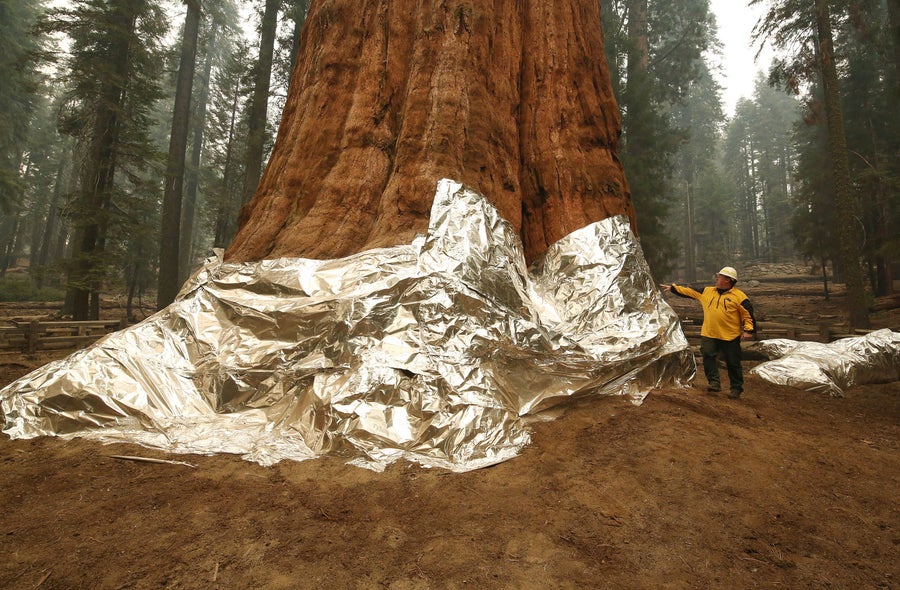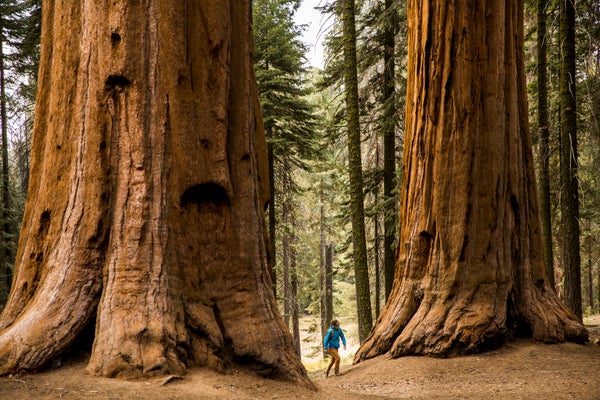When the Grizzly Giant sprouted from the ground in what is now Yosemite National Park, the Roman Republic was nearly two centuries away from forming, Buddhism would not develop for at least more than a century, and the geoglyphs making up the Nazca Lines of southern Peru would not be etched for around 200 years.
At an estimated 2,700 years old (and possibly even older), this giant sequoia is one of the oldest trees in the world—a majestic specimen of a remarkable redwood species that has evolved to withstand the flames that periodically sweep through its environment. Some of these trees, which can grow more than 300 feet tall (about as high as a 30-story building) and dozens of feet wide, are the world’s most massive tree and one of the largest organisms on earth.
Giant sequoias are found only in about 73 groves scattered along the western slopes of California’s Sierra Nevada, from Tahoe National Forest to the Giant Sequoia National Monument northeast of Bakersfield, Calif. President Abraham Lincoln first set aside the Grizzly Giant and the other sequoias of Mariposa Grove as federally protected in 1864, eight years before the designation of the country’s first national park.
On supporting science journalism
If you're enjoying this article, consider supporting our award-winning journalism by subscribing. By purchasing a subscription you are helping to ensure the future of impactful stories about the discoveries and ideas shaping our world today.

Operations Section Chief Jon Wallace looks over General Sherman, a historic giant sequoia, that was protected from fires with structure wrap in Sequoia National Park in 2021. Hundreds of firefighters were battling to protect several groves of giant sequoias, warning the enormous ancient trees were at risk from out-of-control blazes. Credit: Gary Kazanjian/AFP via Getty Images
Mariposa Grove has recently been threatened by the Washburn Fire, which began on July 7 and has burned through more than 4,000 acres of forest. The Mariposa trees have so far escaped the fate of Alder Creek Grove, another stand of sequoias in the Giant Sequoia National Monument that was scorched during the Castle Fire in 2020. Almost all of the trees in the most intense part of the fire perished—amounting to the loss of 10 to 14 percent of all living giant sequoias. There is concern that more of these towering giants could meet the same fate, with wildfires increasingly amplified by rising temperatures and decades of fire suppression that have allowed branches, leaves and other fuel to build up.
To learn more about these extraordinary American icons and how conservationists and others are working to better protect them, Scientific American spoke with Paul Ringgold, chief program officer of the nonprofit Save the Redwoods League.
[An edited transcript of the interview follows.]
How are giant sequoias able to grow so big?
It’s still a question that hasn’t been completely answered. But we certainly know that, like their cousin the coast redwood, these trees have adapted to be very effective at pulling in water and translocating that water high up into the canopy. Their cellular structures seem to be very specifically adapted to draw water to such great heights. But I think, also, just the resilience that they have—they’ve adapted to be able to survive climate impacts and threats such as droughts and wildfire—has allowed them to continue growing for so much longer than most of the trees they are coexisting with.
Also, the specific adaptations in their bark, which is a natural insulator—that very thick and fibrous bark that can get up to two feet thick in some of the largest trees—it’s a perfect insulator. They’re super trees. That bark allows them to withstand the impacts of a fire where other trees often have not. And that adaptation, I think, has gotten them to where they are.
What are some of the other ways they have adapted to live with fire?
The height of the crown, the height of the branches, is also a part of that adaptation. In the face of natural fires that occur in that environment, you generally don’t have flames reaching up into the canopy.
I think the key to their adaptation and their survival is also that they were adapted to reseed and repopulate and regenerate in a fire-adapted environment. The giant sequoia cones are serotinous, which means that they don’t open and release seed unless subjected to heat. In a normal situation, a ground fire would spark the release of the seeds from those cones, at the same time providing a bare mineral-soil seedbed for the sequoia. These [seeds] will not do well—and generally don’t survive—if they fall onto a layer of litter on the soil. They just can’t withstand the dryness of the Sierran summer without having that mineral soil that they can start getting down into and reaping the rewards of the moisture that is stored there.
How are these trees being affected by climate change?
To start with, we’re experiencing these much longer periods of prolonged drought. And that has been a significant challenge for a number of reasons. I think the first one is there’s less moisture—and there’s increased competition for that moisture—resulting from the fact that there has not been the natural thinning of trees in these groves. In addition to that, the drought itself has been a challenge for the sequoia, regardless of the competition or the situation that we find ourselves in with the fuels buildup. There have been studies that have shown that the sequoia in some of these really, really serious drought periods during the summer are demonstrating some dieback in their foliage—not enough to kill the tree but enough to demonstrate that the tree is definitely stressed right now. There’s no doubt that even those trees that have withstood drought historically over the past thousands of years are definitely stressed right now as a result of the prolonged drought.
And then that stress exacerbates these other stressors that are coming into the environment: For example, the fact that we now see these bark beetle populations exploding. What otherwise would be trees that are stress-free and robust and able to withstand some level of insect attack are falling victim to these insects because they’re under so much stress—and because the beetle populations are so much larger.
How can we protect giant sequoias from the more frequent and intense wildfires we’re seeing now?
I think the first thing to keep in mind is that the giant sequoia groves—which represent a very small portion of the Sierran landscape—exist within the broader context of this same challenge around the fuels buildup that exists throughout the Sierra forests. I think that most of the wildfires that we’ve seen started outside the groves. The [Save the Redwoods League], of course, is focused on the protection of the Sequoia groves. But this all leads to one of our conclusions, which is that we can’t really accomplish effective protection of the groves by doing work just inside them. We’ve already reduced the level of fuels in some groves. We need to do that not just in the groves themselves but in sort of this buffer area surrounding the groves to make sure that adjacent fire doesn’t carry into the crowns of groves that have been prepared for low-intensity ground fire.
The biggest challenge that we have right now is that we have such an incredible buildup of fuel on the landscape, and when these wildfires start, they become completely impossible to control. We saw that just last year—for the first time, we saw a fire that carried across the summit of the Sierra and down into Lake Tahoe. There are unprecedented events that we’re seeing, at least within our history and our memory. And I think the challenge is the fact that you have these unmanageable fires that are burning so intensely that when they do burn through sequoia groves, they are wiping out significant populations of large sequoias within those groves that would otherwise have been able to withstand the fire.
And then the other concern we have is around type conversion and the fact that there was 100 percent mortality in the sequoias [hit by some of the recent fires]. So without some active measures to reintroduce seedlings through plantings or reseeding and watering, we’re going to see conversion of what was a sequoia grove to brush fields and other species—because the fire was so hot that not only did it kill the standing trees, but it killed all of the seeds and cones that were ready otherwise to reestablish that population.
Is there anything we can do to protect trees when there is an imminent threat of fire?
Yes, in fact, [fire management staffers] did some of that in the Alder Creek Grove when that fire burned, and they’re doing it now in the Mariposa Grove—and that is ground-based sprinkler systems. I think oftentimes people assume that they’re up in the trees, but it really is to keep the floor of the forest moist, which really is effective in reducing the severity of fire as it burns through those areas.
I know last year [fire managers] were doing some wrapping of the larger, named monarchs [the term for the largest individuals in a grove] that they wanted to make sure were protected with a foil insulator. They have not done that this year in the Mariposa Grove, but they did wrap the buildings there to protect them. But what I’ve been hearing is that they’re now concerned that wrapping up the trees in that material may actually have an adverse impact, in the sense of putting foil over a casserole going into the oven, that it may actually reflect some of that heat back into the tree.
When I first saw that the trees were being wrapped [last year], I was a little bit puzzled, because as far as I know, the threat to old-growth sequoias is not ground fire; it’s crown fire. If you have a fire burning through a grove, and you’re wrapping the trees, you’re basically putting the Band-Aid on the part that doesn’t really need it.
Part of the reason we want to protect these species is their unique grandeur, and it seems difficult to convey how immense they are, even in photographs.
You really do have to experience it in person, I think, to get the full sense of awe. And that’s what I love about the giant sequoias and coast redwoods—that they exist in such different contexts. With the coast redwood forests, you get into these forests, and you can go for miles, and you’re experiencing this consistent pattern on the landscape of these large trees. Whereas the giant sequoia exist in these very remote, oftentimes very secluded groves where you just sort come around a corner and, all of a sudden, there’s a whole other world. I just love that sense of surprise.
